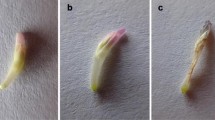Abstract.
Flower colour variegation is not only a phenomenon of importance to horticulture, the phenotype involved is also often used as a scientific model system for the study of complex gene regulation processes. In the course of such studies on azalea, we observed a correlation between flower colour patterns, flower morphology and somatic polyploidy. Using high-resolution flow cytometry of nuclear DNA, the ploidy level was determined in flowers of different azalea sport families. Sports exhibiting variegated flowers with broad (>7 mm), differently coloured, petal edges (picotee type) proved to be tetraploid in the petal edge but diploid in the rest of the flower tissue. Neither flower colour pattern nor ploidy differences are periclinal chimeric in origin, but seem to be correlated with the topographic location of the cells within the flower tissue, i.e. the margin of the petals. The possible role of gene dosage effects and cell size involved in the remarkable correlation between somatic polyploidy, (flavonoid) gene expression and flower morphology is discussed.
Similar content being viewed by others
Author information
Authors and Affiliations
Additional information
Revision received: 15 April 2001
Rights and permissions
About this article
Cite this article
Schepper, S., Leus, L., Mertens, M. et al. Somatic polyploidy and its consequences for flower coloration and flower morphology in azalea. Plant Cell Rep 20, 583–590 (2001). https://doi.org/10.1007/s002990100372
Received:
Accepted:
Published:
Issue Date:
DOI: https://doi.org/10.1007/s002990100372




